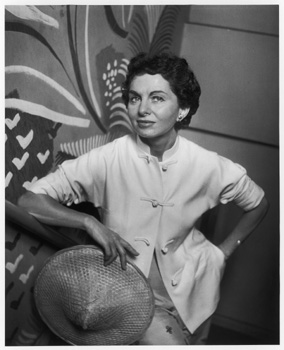
To suggest "active hands," Cashin modeled her jacket, adapted
from Chinese work clothes, with the sleeves pushed up to the elbow.
Some of her designs for this collection came with elasticized
sleeves, permanently set in the "at-work" position.
Bonnie Cashin for Adler and Adler, 1950.
|
my kind of a girl, in leather
1950-1985
1950-1953
After Cashin's first travel overseas, she returned to Hollywood
with a dim view of contemporary fashion. She criticized designers
in Paris for not responding to the requirements of modern living,
summing up her feelings by commenting "You can't stuff a dress
weighing twenty pounds into an overnight bag." Anxious to equip
the curious nomad, like herself, and disliking the safe berth
that Hollywood had become, in 1949 Cashin designed her last film
costumes and returned to Seventh Avenue.
Passionately concerned about not "torturing" materials, Cashin
devised ways to frame and flatter the body with simple geometry
and luxury materials, hence her fondness for ponchos, mantles,
capes and togas. She featured these garments in her 1949 return
collection, titled "We Live as We Please." Emphasizing her objective
of dressing "on-the-go" women like herself, she advocated rejection
of clothing with "pointless" trimmings, and insistence on "uncluttered,
mobile and unselfconscious" wardrobes that would satisfy the urge
for adornment as well as relate in a practical way to the day's
living patterns. Using her status as a Hollywood insider, Cashin
introduced many of her maverick ideas through a filter of film-star
glamour. She encouraged new thought about utilitarian clothing
concepts via wildly unconventional, and press-friendly, combinations,
including ostrich feather aprons and mink ponchos, that were made
in a range of materials for the ready-to-wear market. |